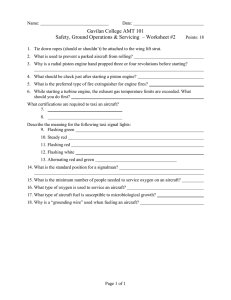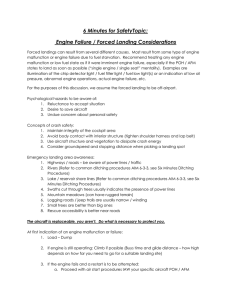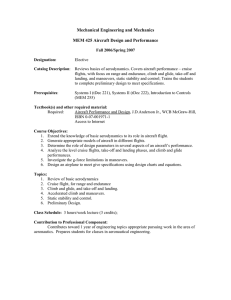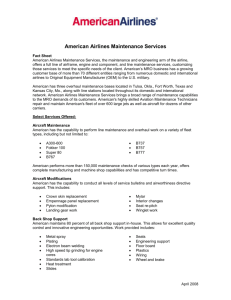dealing with engine failure - the Light Aircraft Association
advertisement
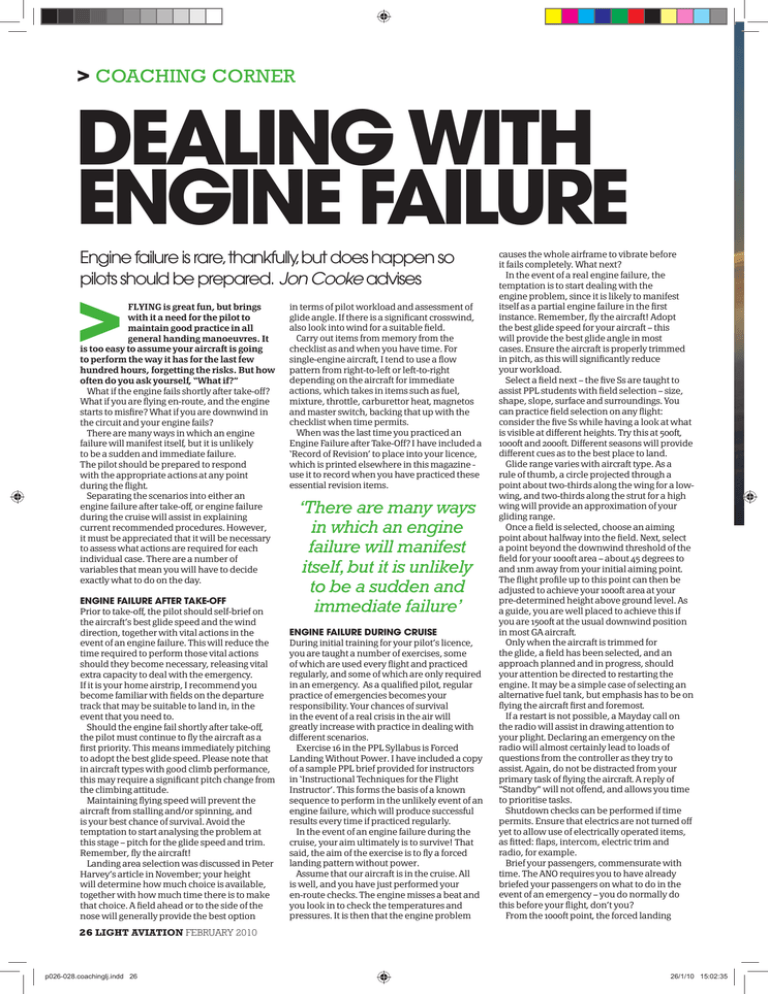
> COACHING CORNER DEALING WITH ENGINE FAILURE Engine failure is rare,thankfully,but does happen so pilots should be prepared. Jon Cooke advises FLYING is great fun, but brings with it a need for the pilot to maintain good practice in all general handing manoeuvres. It is too easy to assume your aircraft is going to perform the way it has for the last few hundred hours, forgetting the risks. But how often do you ask yourself, “What if?” What if the engine fails shortly after take-off? What if you are flying en-route, and the engine starts to misfire? What if you are downwind in the circuit and your engine fails? There are many ways in which an engine failure will manifest itself, but it is unlikely to be a sudden and immediate failure. The pilot should be prepared to respond with the appropriate actions at any point during the flight. Separating the scenarios into either an engine failure after take-off, or engine failure during the cruise will assist in explaining current recommended procedures. However, it must be appreciated that it will be necessary to assess what actions are required for each individual case. There are a number of variables that mean you will have to decide exactly what to do on the day. ENGINE FAILURE AFTER TAKE-OFF Prior to take-off, the pilot should self-brief on the aircraft’s best glide speed and the wind direction, together with vital actions in the event of an engine failure. This will reduce the time required to perform those vital actions should they become necessary, releasing vital extra capacity to deal with the emergency. If it is your home airstrip, I recommend you become familiar with fields on the departure track that may be suitable to land in, in the event that you need to. Should the engine fail shortly after take-off, the pilot must continue to fly the aircraft as a first priority. This means immediately pitching to adopt the best glide speed. Please note that in aircraft types with good climb performance, this may require a significant pitch change from the climbing attitude. Maintaining flying speed will prevent the aircraft from stalling and/or spinning, and is your best chance of survival. Avoid the temptation to start analysing the problem at this stage – pitch for the glide speed and trim. Remember, fly the aircraft! Landing area selection was discussed in Peter Harvey’s article in November; your height will determine how much choice is available, together with how much time there is to make that choice. A field ahead or to the side of the nose will generally provide the best option in terms of pilot workload and assessment of glide angle. If there is a significant crosswind, also look into wind for a suitable field. Carry out items from memory from the checklist as and when you have time. For single-engine aircraft, I tend to use a flow pattern from right-to-left or left-to-right depending on the aircraft for immediate actions, which takes in items such as fuel, mixture, throttle, carburettor heat, magnetos and master switch, backing that up with the checklist when time permits. When was the last time you practiced an Engine Failure after Take-Off? I have included a ‘Record of Revision’ to place into your licence, which is printed elsewhere in this magazine use it to record when you have practiced these essential revision items. ‘There are many ways in which an engine failure will manifest itself, but it is unlikely to be a sudden and immediate failure’ ENGINE FAILURE DURING CRUISE During initial training for your pilot’s licence, you are taught a number of exercises, some of which are used every flight and practiced regularly, and some of which are only required in an emergency. As a qualified pilot, regular practice of emergencies becomes your responsibility. Your chances of survival in the event of a real crisis in the air will greatly increase with practice in dealing with different scenarios. Exercise 16 in the PPL Syllabus is Forced Landing Without Power. I have included a copy of a sample PPL brief provided for instructors in ‘Instructional Techniques for the Flight Instructor’. This forms the basis of a known sequence to perform in the unlikely event of an engine failure, which will produce successful results every time if practiced regularly. In the event of an engine failure during the cruise, your aim ultimately is to survive! That said, the aim of the exercise is to fly a forced landing pattern without power. Assume that our aircraft is in the cruise. All is well, and you have just performed your en-route checks. The engine misses a beat and you look in to check the temperatures and pressures. It is then that the engine problem causes the whole airframe to vibrate before it fails completely. What next? In the event of a real engine failure, the temptation is to start dealing with the engine problem, since it is likely to manifest itself as a partial engine failure in the first instance. Remember, fly the aircraft! Adopt the best glide speed for your aircraft – this will provide the best glide angle in most cases. Ensure the aircraft is properly trimmed in pitch, as this will significantly reduce your workload. Select a field next – the five Ss are taught to assist PPL students with field selection – size, shape, slope, surface and surroundings. You can practice field selection on any flight: consider the five Ss while having a look at what is visible at different heights. Try this at 500ft, 1000ft and 2000ft. Different seasons will provide different cues as to the best place to land. Glide range varies with aircraft type. As a rule of thumb, a circle projected through a point about two-thirds along the wing for a lowwing, and two-thirds along the strut for a high wing will provide an approximation of your gliding range. Once a field is selected, choose an aiming point about halfway into the field. Next, select a point beyond the downwind threshold of the field for your 1000ft area – about 45 degrees to and 1nm away from your initial aiming point. The flight profile up to this point can then be adjusted to achieve your 1000ft area at your pre-determined height above ground level. As a guide, you are well placed to achieve this if you are 1500ft at the usual downwind position in most GA aircraft. Only when the aircraft is trimmed for the glide, a field has been selected, and an approach planned and in progress, should your attention be directed to restarting the engine. It may be a simple case of selecting an alternative fuel tank, but emphasis has to be on flying the aircraft first and foremost. If a restart is not possible, a Mayday call on the radio will assist in drawing attention to your plight. Declaring an emergency on the radio will almost certainly lead to loads of questions from the controller as they try to assist. Again, do not be distracted from your primary task of flying the aircraft. A reply of “Standby” will not offend, and allows you time to prioritise tasks. Shutdown checks can be performed if time permits. Ensure that electrics are not turned off yet to allow use of electrically operated items, as fitted: flaps, intercom, electric trim and radio, for example. Brief your passengers, commensurate with time. The ANO requires you to have already briefed your passengers on what to do in the event of an emergency – you do normally do this before your flight, don’t you? From the 1000ft point, the forced landing 26 LIGHT AVIATION FEBRUARY 2010 p026-028.coachinglj.indd 26 26/1/10 15:02:35 In the cruise and all is well, but are you prepared should an engine problem occur? SIGHT LINE ANGLE Aim to maintain aiming point at constant sight line angle during turn from base leg onto final EXAMPLE A EXAMPLE B Aircraft is low on the approach and will land short of X. Aircraft is too high on the approach and will land too deep. Adjust glide slope. TARGET SIGHT LINE This is the ideal picture and an arrival at X is guaranteed. SIDE VIEW EXAMPLE B IDEAL EXAMPLE A TURN ONTO FINAL Example B If too high, extend approach to give more time to lose height. Side elevation shows how incorrect sight line angle translates into poor arrival. Example A If too low, ‘cut the corner’ to shorten final approach. A B FEBRUARY 2010 LIGHT AVIATION 27 p026-028.coachinglj.indd 27 26/1/10 15:02:53 > COACHING CORNER ‘If you are not in current practice for side-slipping, I highly recommend that you obtain some instruction’ not in current practice for side-slipping, I highly recommend that you obtain some instruction. Used correctly, it may save your life, and is excellent at providing the pilot with a variable vertical profile correction, and assists in correction for wind gradient in the latter stages. Once you are certain of achieving your aiming point, you can move your aiming point towards the threshold of the field by use of flaps and/ or side-slipping. Make sure you fly the aircraft, and don’t be tempted to stretch the glide – many pilots have shown that it doesn’t work. Field type will determine the type of landing required. Ideally, a soft field landing with touchdown as slow as possible will produce best results and least damage. Aircraft and undercarriage type, plus surface type and condition will determine what type of landing will result. Suffice to say that if we achieve our initial aim – to survive – then it will have been successful. Anything more than that is a bonus! While instructing, I have seen many failed attempts at Practice Forced Landings. Generally, lack of success can be attributed to failure to practice the required techniques regularly. I suggest that any time the opportunity presents itself, providing you have properly briefed, then practice the procedures described. When flying to a familiar airfield with a long runway, if traffic permits then join overhead for a Practice Forced Landing. Remember to warm the engine every 1000ft though, and convert it into a normal circuit if workload becomes high due to traffic, ATC, or aircraft considerations. Better still, call a coach to come along, to help with the lookout while you are concentrating on the flying, and critique your practice. Always be prepared to convert a PFL into a real forced landing! There have been a number of occasions where the ‘P’ has been taken! I cannot emphasise enough that all pilots are responsible for ensuring that they are in current practice in normal and emergency procedures for their aircraft type. For single engine aircraft, this includes EFATOs, forced landings and glide circuits. Put the ‘Record of Revision’ provided into your licence, and keep a track of when you last flew these essential tasks. Instead of waiting for your next Class Rating Renewal, contact an LAA Coach to help you with revision of forced landings – it may well save your life. F O L D H E R E becomes the same exercise as a glide approach. Your initial aiming point has been selected halfway into the field initially. This allows a margin for selection of flaps, as well as an area to allow for misjudgment and abnormal wind gradient. There is an old adage that it is better to hit the far hedge at 30kts than the near hedge at 70kts. This is indeed true, hence selecting the aiming point halfway into the field in the first instance. When flying the glide approach, there are a number of methods for height loss. You will appreciate that it is not possible to gain height, although, if low, turning towards the aiming point will shorten the distance, thereby altering your sight line angle. Use of the sight line angle is now commonly taught, and is an excellent method for assessing the glide, once you have practiced it a few times. Simply, imagine the aiming point as a fixed point in the windscreen. If that point moves up the screen, the aircraft is descending below the profile; conversely if the point moves down the screen then the aircraft is above the profile. Your reference point in a constant position in the screen provides a constant sight line angle. Varying your bank angle during the base leg to finals turn allows assessment and correction of the sight line angle in this manner. Other methods to use are S-turns, side-slipping, diving off height, orbiting, or adjustment of circuit legs. If you are 28 LIGHT AVIATION FEBRUARY 2010 p026-028.coachinglj.indd 28 26/1/10 15:03:19
